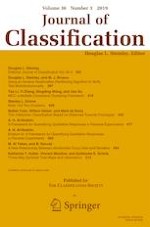29.03.2019
Card Sorting Data Collection Methodology: How Many Participants Is Most Efficient?
Erschienen in: Journal of Classification | Ausgabe 3/2019
EinloggenAktivieren Sie unsere intelligente Suche, um passende Fachinhalte oder Patente zu finden.
Wählen Sie Textabschnitte aus um mit Künstlicher Intelligenz passenden Patente zu finden. powered by
Markieren Sie Textabschnitte, um KI-gestützt weitere passende Inhalte zu finden. powered by
